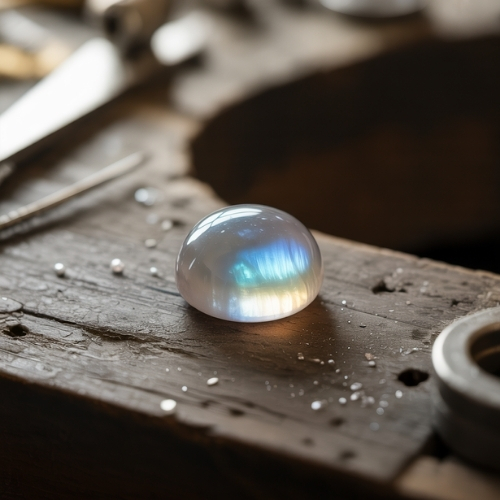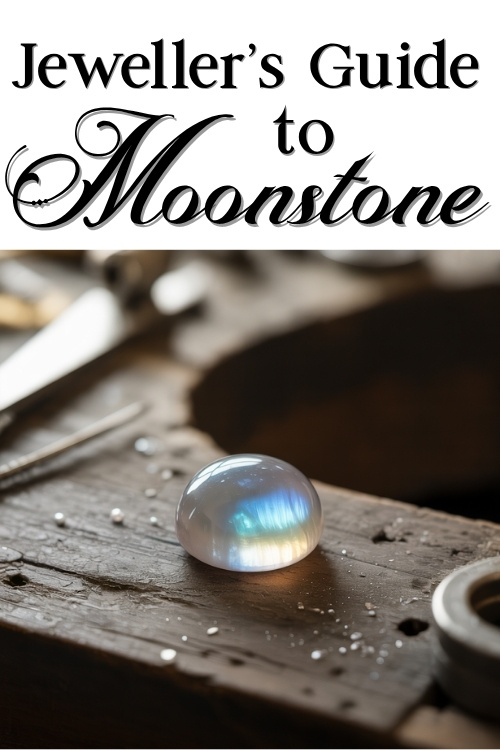Estimated reading time: 4 minutes
With its luminous glow and dreamy shimmer, moonstone has long been a favourite among designers seeking a soft, ethereal beauty. Whether nestled in dainty rings or glowing at the centre of bohemian-inspired pendants, this feldspar offers a quiet kind of magic.
Jump to:
Basic Identification Information
Name & Synonyms
Moonstone; historically also known as adularia
Species
Feldspar
Colour Range
White, cream, peach, grey, brown, yellow, blue, and rainbow varieties
Often displays adularescence (a soft, internal shimmer caused by light scattering through microscopic layers within the gem)
Refractive Index
1.518–1.524
Birefringence
0.005–0.008
Optical Sign
Biaxial + or –, depending on composition
Pleochroism
None
Specific Gravity
2.56–2.60
Fluorescence
Usually none
Some specimens may show a weak yellow, green, or blue fluorescence under UV light
Lustre
Vitreous (glass like) to pearly
Clarity
As moonstone is only transulcent at best, it doesn’t have a clarity class. It always has inclusions, which are responsible for the adularescence effect.
Gems Often Mistaken For Moonstone
Labradorite, opalite (glass), chalcedony
Mohs Hardness
6–6.5
Wearability
Fair
Birthstone
June (along with to pearl and alexandrite)
Spotting Synthetic (Lab-Grown) Moonstone
Moonstone is not synthesised in laboratories for jewellery purposes. However, glass imitations (like “opalite”) are often mislabelled as moonstone. These can usually be spotted by their uniform appearance, lack of shimmer, and occasional bubble inclusions.
Common Treatments
Moonstone is generally untreated.
The only thing to look out for in terms of treatments is rare cases of lower-quality stones being coated or impregnated with resin to improve durability or appearance.
Durability & Setting Considerations
With a hardness of 6–6.5, moonstone is softer than most everyday objects, even household dust. It also has perfect cleavage in two directions, making it prone to splitting if struck. Despite this moonstone is a very popular jewellery gemstone.
Jewellers should take special care when setting moonstone, especially in rings or exposed designs. Bezel settings offer more protection than prongs, which can place pressure on the edges and risk chipping.
Avoid casting in place or exposing the stone to rapid temperature changes. If soldering near a moonstone that can’t be removed, use heat-protective methods to avoid thermal shock.
When polishing, opt for gentle abrasives to preserve its delicate surface and luminous sheen.
🛍️ Explore our selection of pre-owned Moonstone Gemstones for your next jewellery creation.
Care Instructions
Cleaning
Use warm, soapy water and a soft brush.
Avoid ultrasonic and steam cleaners as these can cause internal fractures.
Storage
Store separately from harder gemstones like sapphire or quartz to prevent scratches. Soft pouches or individual compartments are ideal.
Daily Wear
Moonstone rings should be removed during physical activities such as sports, gardening, or housework to minimise damage.
Market & Ethical Notes
Moonstone is primarily mined in Sri Lanka, India, Myanmar, Madagascar, and Tanzania. Fine-quality blue moonstone from Sri Lanka is especially prized for its clarity and strong adularescence.
Most moonstone mining is small-scale. However, ethical sourcing can be difficult to verify. When possible, purchase through suppliers that provide transparency and traceability regarding their supply chains.
🔗 Learn more about the ethical and environmental story behind Reclaimed and Recycled Gemstones.
Symbolic & Spiritual Meanings
Long associated with lunar energy, moonstone symbolises intuition, inner growth, and emotional balance. Ancient Romans believed it was formed from frozen moonlight, while in Hindu mythology it is linked to divine feminine power.
Moonstone is often used in crystal healing to support new beginnings, encourage calm reflection, and balance emotions. In spiritual practices, it is commonly associated with the crown and third eye chakras, enhancing intuition and insight.
🔗 Dive deeper into Moonstone’s Symbolic & Spiritual Meanings
Etymology
The name moonstone reflects the gem’s moon-like glow, an optical effect known as adularescence. This term derives from Mount Adular in Switzerland, a historic source of fine-quality specimens that inspired the gem’s poetic association with moonlight.
🔗Curious about how moonstone was viewed in ancient cultures? Explore Moonstones myths and legends
📌 Save this jeweller’s guide to moonstone for quick reference next time you’re working with this stunning gem.


